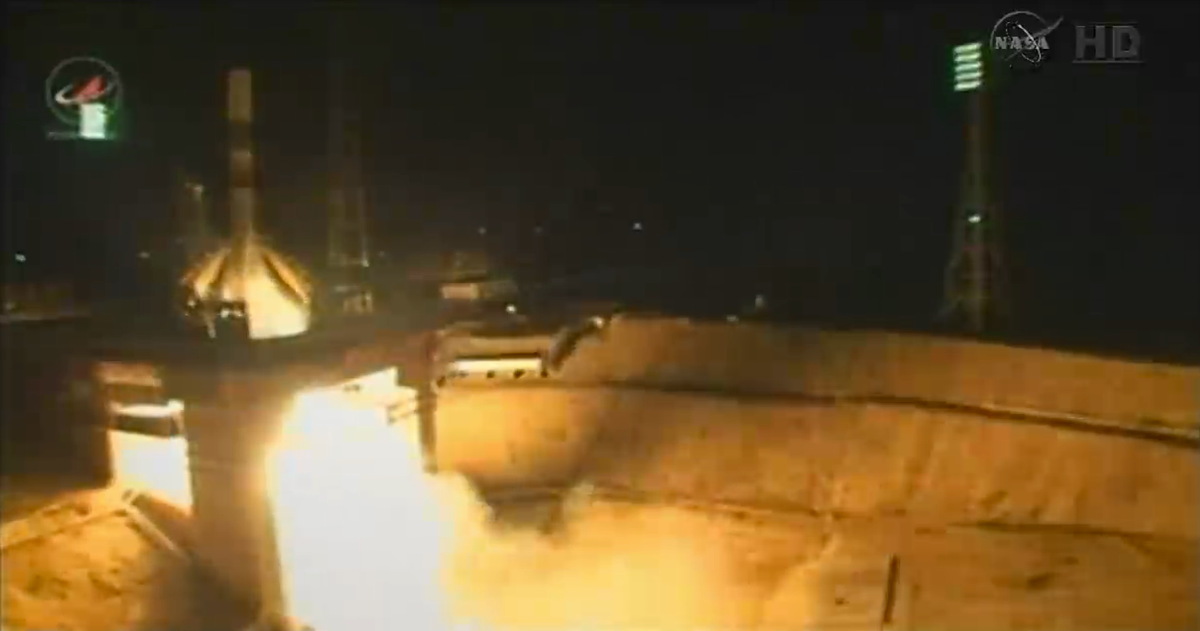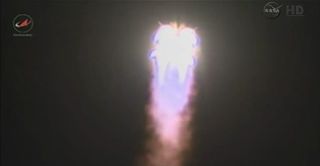Robotic Russian Cargo Ship Launches on Express Trip to Space Station

An unmanned Russian spacecraft filled with supplies for the six crewmembers living on the International Space Station launched on an express delivery run to the orbiting outpost today (July 23).
The unmanned Progress 56 craft launched atop a Russian-built Soyuz rocket from the Baikonur Cosmodrome in Kazakhstan at 5:44 p.m. EDT (2144 GMT), 3:44 a.m. local time Thursday (July 24). The Progress is expected to dock to the space station's Pirs docking compartment at 11:30 p.m. EDT (0330 GMT) tonight. You can watch the spacecraft's arrival live on Space.com, via NASA TV, starting at 11 p.m. EDT (0300 GMT).
"There you see Progress 56 lifting off from the Baikonur Cosmodrome in Kazakhstan on its way to the International Space Station," NASA spokesperson Brandi Dean said during the NASA TV launch broadcast. [How Russia's Progress Spaceship Work (Infographic)]
The Progress is carrying about 5,700 lbs (2,587 kilograms) of food and other supplies for the Expedition 40 crew currently aboard the station. The spacecraft is also delivering 1,764 lbs (800 kg) of propellant, 57 pounds (26 kg) of air, 48 pounds (22 kg) of oxygen, 926 pounds (420 kg) of water and 2,910 pounds (1,320 kg) of supplies, spare parts and experiment hardware, according to NASA.
Historically, Progress ships have taken about two days to arrive at the station. Since 2012, however, the Russian crafts have been flying accelerated, six-hour journeys to the science laboratory. Astronauts and cosmonauts have also recently started flying these quick, four-orbit flights aboard the manned Soyuz capsules that deliver new crewmembers to the station.

A different Progress craft, dubbed Progress 55, left the space station on Monday (July 21) to make room for the new cargo ship. Progress 55 is now flying a safe distance away from the orbiting outpost, where it will perform a series of engineering tests before it intentionally burns up over the Pacific Ocean on July 31, according to NASA.
Progress ships are similar to the crew-carrying Soyuz capsules. They both consist of three modules, but instead of the Soyuz craft's crew compartment, Progress ships are equipped with a fuel module for space station maneuvers.
Get the Space.com Newsletter
Breaking space news, the latest updates on rocket launches, skywatching events and more!
A variety of cargo ships regularly visit the space station. NASA has deals with two private companies — SpaceX and Orbital Sciences — to fly cargo to the station in their unmanned ships. Japan's H-II Transfer Vehicles and Europe's Automated Transfer Vehicles (ATV) also make runs to the station.
The space station currently plays host to a crew of six. NASA astronauts Steve Swanson and Reid Wiseman, European Space Agency astronaut Alexander Gerst and Russian cosmonauts Max Suraev, Alexander Skvortsov and Oleg Artemyev make up the Expedition 40 crew.
Follow Miriam Kramer @mirikramer and Google+. Follow us @Spacedotcom, Facebook and Google+. Original article on Space.com.
Join our Space Forums to keep talking space on the latest missions, night sky and more! And if you have a news tip, correction or comment, let us know at: community@space.com.

Miriam Kramer joined Space.com as a Staff Writer in December 2012. Since then, she has floated in weightlessness on a zero-gravity flight, felt the pull of 4-Gs in a trainer aircraft and watched rockets soar into space from Florida and Virginia. She also served as Space.com's lead space entertainment reporter, and enjoys all aspects of space news, astronomy and commercial spaceflight. Miriam has also presented space stories during live interviews with Fox News and other TV and radio outlets. She originally hails from Knoxville, Tennessee where she and her family would take trips to dark spots on the outskirts of town to watch meteor showers every year. She loves to travel and one day hopes to see the northern lights in person. Miriam is currently a space reporter with Axios, writing the Axios Space newsletter. You can follow Miriam on Twitter.









